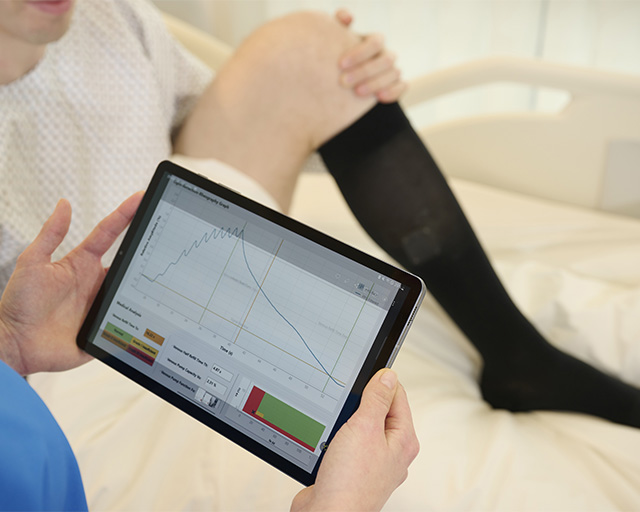Venous diseases not only cause suffering for the affected individuals, but also significant costs for the economy. The estimated costs currently exceed €2 billion annually.
Deep vein thrombosis
In addition to less severe conditions such as varicose veins, deep vein thrombosis (DVT) is particularly associated with high risks for affected individuals and costly treatment. Since the blood clot that obstructs blood flow in the deep leg veins is often diagnosed late due to diffuse symptoms, subsequent conditions such as venous insufficiency or, in severe cases, pulmonary embolism or post-thrombotic syndrome become unavoidable.
In the general population, 1 to 2 cases of DVT are recorded per 1000 individuals each year. This number exponentially increases with age, so that in elderly patients, the incidence is almost 1 in 100. With the projected aging of the population in Germany, there is a need for action in this area.
veinXam
Fraunhofer Institute for Computer Graphics Research is developing the veinXam system, which aims to reduce the risks of thrombotic disease by continuously monitoring venous function in the deep leg veins.
veinXam is integrated into a compression stocking and continuously monitors venous blood flow using non-invasive sensors.
When detecting pathological changes, an alarm is sent to the hospital staff or to the patient's smartphone in case of home use. This allows for early intervention to be initiated, avoiding serious illness and costly treatment.
In addition to vein function, the sensor technology present in veinXam can measure other biosignals of a patient, such as pulse, blood oxygen saturation, and respiration. These data can be wirelessly transmitted to any system for further processing. In this way, the system offers a user-friendly option for comprehensive vital parameter monitoring, particularly in a hospital environment.
The measurement approach of veinXam
veinXam is based on the established technique of photoplethysmography used in venous diagnostics: Venous blood has a significantly higher concentration of deoxygenated hemoglobin compared to arterial blood. The resulting altered optical absorption property can be used to assess the venous refill time and thus the function of the deep leg vein valves.
 Fraunhofer Institute for Computer Graphics Research IGD
Fraunhofer Institute for Computer Graphics Research IGD